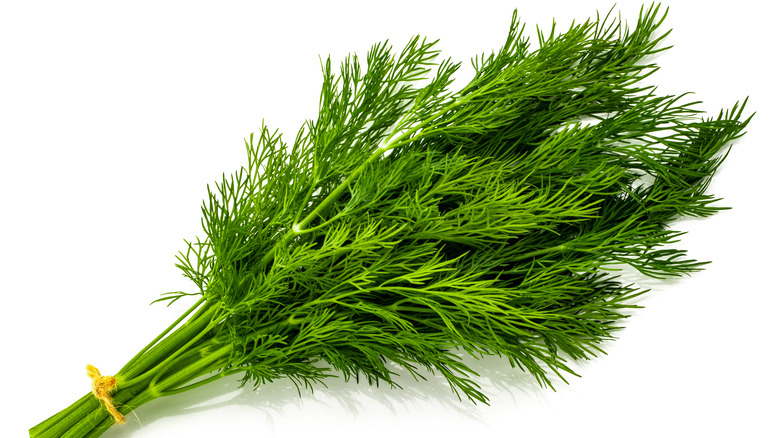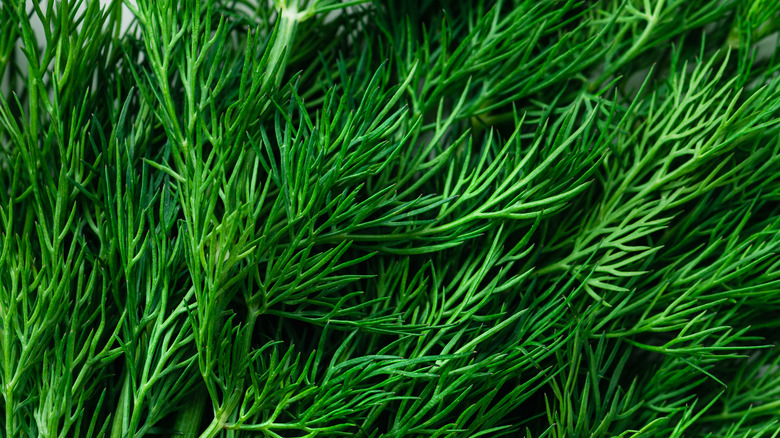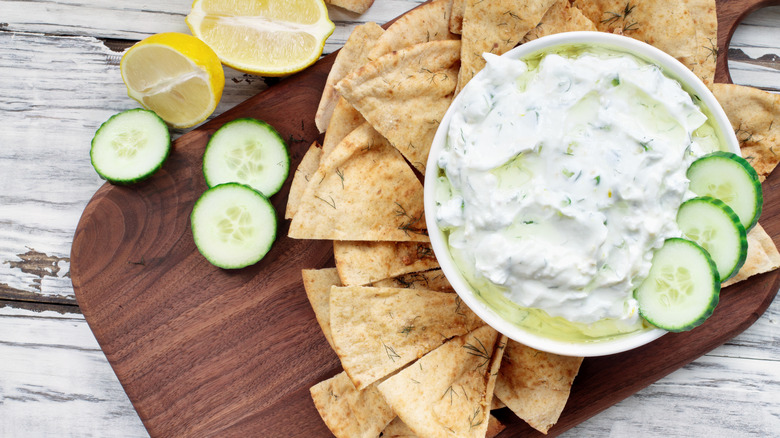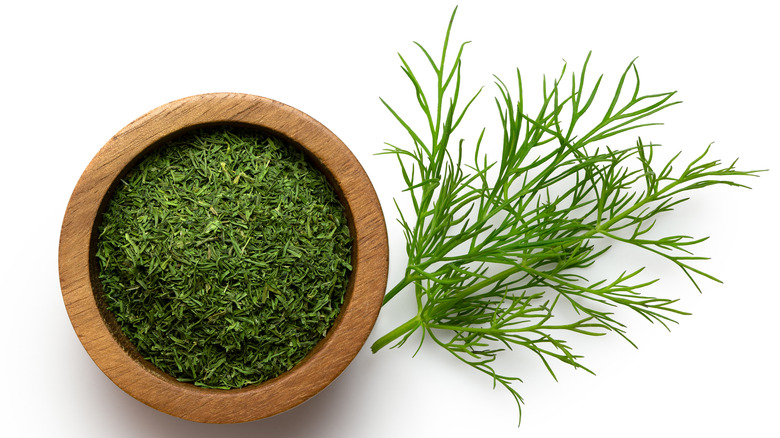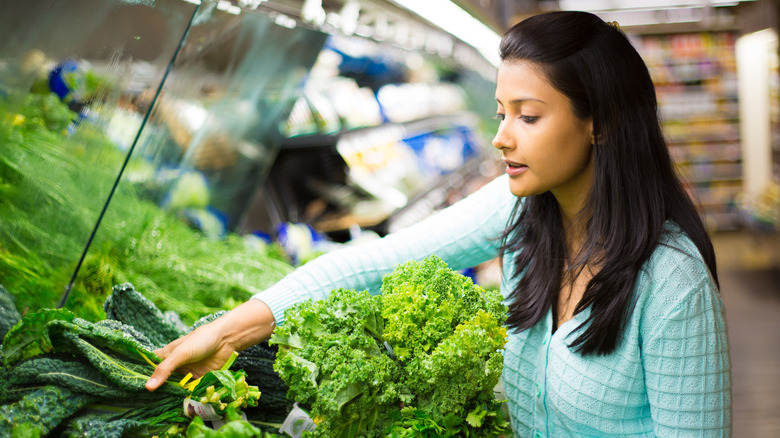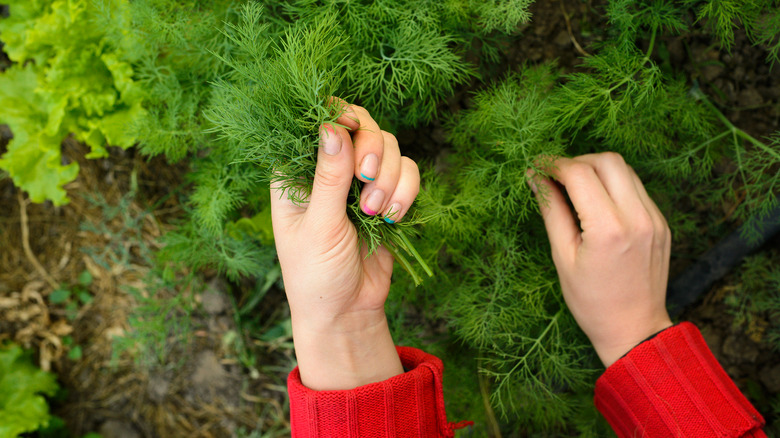What Is Dill And How Do You Use It?
In the pantheon of fresh herbs, we have to say that dill is one of our favorites. Sometimes unappetizingly called "dill weed," this wispy, feathery, dark green herb has a unique but strong flavor that can be compared to fennel or anise. If you've ever eaten a classic potato salad or a snappy dill pickle, you know exactly what we're describing.
Dill (Anethum graveolens) is an annual herb that blooms in the summer months, says Missouri Botanical Garden, but is widely grown in greenhouses and is available in most grocery stores year-round. It can grow to an impressive height of five feet, but you'll want to cut and eat your dill before its wide yellow flowers appear; once flowered, dill becomes more bitter and not as ideal for cooking. The leaves are not the only edible part of the plant; dill's flat, oval seeds are also used in cooking and taste a bit like caraway. According to Britannica, dill is related to both parsley and celery, though it does not resemble either when it comes to taste.
Dill: a bit of history
Native to the eastern Mediterranean and western Asia, dill is a popular herb worldwide, though it remains a classic ingredient in Greek, Turkish, and Persian recipes. The Spruce Eats shares the name "dill" comes from the old Norse "dylla," meaning to soothe, and has historically been giving to help with upset stomachs and other ailments. In ancient cultures, dill was variously believed to be a good luck charm (Rome), an aphrodisiac (Egypt), and a harbinger of wealth (Greece).
Like many herbs, dill is reputed to have a number of medicinal qualities. In addition to being said to help calm both nerves and muscles, Organic Facts claims dill may settle the stomach, cure hiccups, and ease the pain of inflammatory conditions such as rheumatoid arthritis. Dill seeds might even act as an appetite suppressant; according to The Spruce Eats, Puritans and Quakers passed out the seeds to children during long church services so that they didn't get hungry mid-way.
How to cook with dill
In spite of having a fairly strong taste, dill is actually an extremely versatile ingredient that brings a fresh grassiness to a wide variety of dishes. In general, you will want to keep dill raw, as when the herb is heated, it tends to lose its flavor. Chopped fresh dill is an excellent garnish for many dishes; more specifically, it's often found in ranch or buttermilk dressings, borscht, kosher pickles, chicken soup, spanakopita, and more.
Dill is particularly beloved in Greece and neighboring Turkey, where it is included in a vast range of the dishes, like avgolemono soup or cacık, which is a yogurt dish made with cucumber and herbs. Dill is often also found in a variety of lamb dishes and sauces.
Fresh dill vs. dried dill
Though many of us are familiar with fresh dill, dried dill and dried dill seeds are similarly widely sold. As with most dried herbs, unfortunately, dried dill simply lacks the flavor and vibrancy of its fresh counterpart, and is best avoided. If dried is the only version you can find, you can use a little more of it than the fresh to get more flavor out of it; dishes in which dried dill might pass muster include buttermilk or ranch dressing, creamy dips (like this zucchini tzatziki), and oven-roasted potatoes or chicken.
Dill seeds are always dried and (like dried dill) are usually found in the supermarket spice aisle. Mild in flavor, dill seeds are often used in pickling recipes, for breads, and sprinkled on roast meats or vegetables. The seeds are also used (sometimes along with fresh dill, sometimes on their own) to make dill vinegar and in corned beef and cabbage.
Where to buy dill
Fresh dill is widely available in most grocery stores, where it's usually sold in the refrigerator case alongside other fresh herbs such as parsley and cilantro. Dill fronds are quite delicate and can bruise or get mushy, so make sure to select a bunch of dill that's fresh, without any wilted leaves. If you happen to find a bunch with the roots still attached, it will last longer in the fridge once you get it home.
To store dill, wrap the bunch loosely in a plastic bag and stash it in the fridge, but try to use it quickly as this herb doesn't have a long shelf life. To keep dill fresh a few days longer (think a week tops), you can place the bunch upright in a jar filled with a few inches of water, pop a plastic bag over the top, and transfer it to the fridge. Dill stored this way with its roots intact will last the longest of all.
How to grow dill at home
If you've got a sunny patch of garden at your disposal, you can try growing dill at home. This herb is one of the easiest to cultivate; all it requires is an area with full sun and fertile, well-draining soil that's relatively sheltered from strong winds (via The Old Farmer's Almanac). Once soil temperatures are consistently above 60 degrees, sow dill seeds directly into the garden, about ¼ inch deep and 18 inches apart. Small dill plants should appear within a couple of weeks; wait another couple of weeks before thinning them to about 12 to 18 inches apart so they have room to grow. Water the dill generously, and you should be good to go.
Remember to harvest the un-flowered fronds for use in cooking; you can then allow some of the dill to flower and drop its seeds, ensuring a steady supply of dill over the season and even the following year. Time to get pickling!
